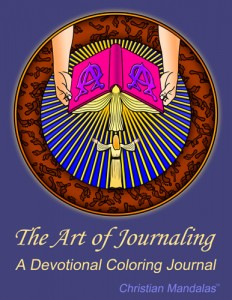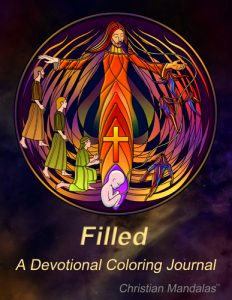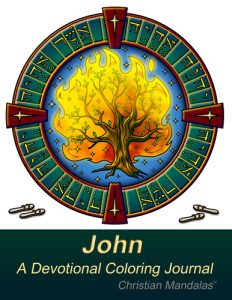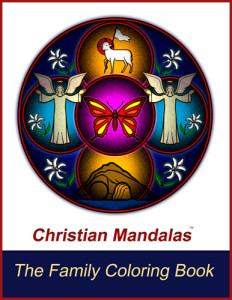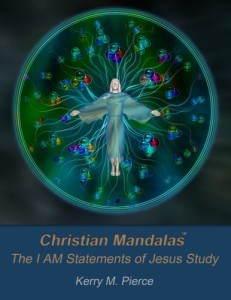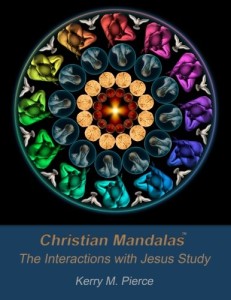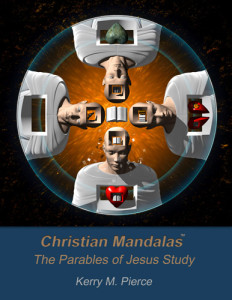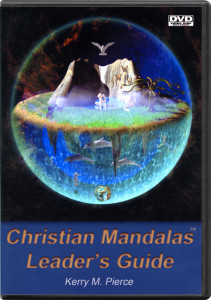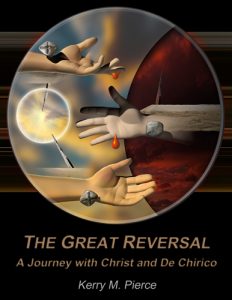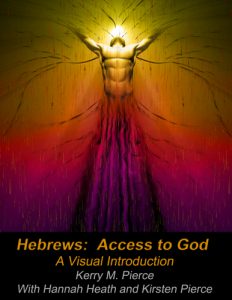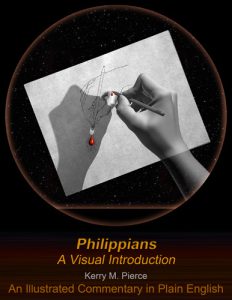Christian Mandalas† Devotional Coloring Journals:
The Art of Journaling
A Devotional Coloring Journal
Christian Art
This is a Christian coloring book. It contains 22 Christian Mandalas to color.
Reflection
This is a Christian study book. Associated with each Christian Mandala is a passage of Scripture. The image you color is intended to add depth to your understanding of the Bible passage on the opposing page. Notes are provided with each passage to help unpack either the passage of Scripture, or the meaning of the Christian symbolism in the mandala.
Journal
Most importantly, this is a Christian journal. With each Christian mandala, and Bible verse, an area is provided to capture your own thoughts as you reflect on God’s Word.
In the book: Move: What 1,000 Churches Reveal about Spiritual Growth, the authors publish the results and summarize their findings on page 167. The authors write: “If they [church pastors] could do only one thing to help people at all levels of spiritual maturity grow in their relationship with Christ, their choice would be equally clear. They would inspire, encourage, and equip their people to read the Bible – specifically, to reflect on Scripture for meaning in their lives.”
By reading the Bible, and by reflecting on Scripture as you color and journal, you will grow in your relationship with Christ.
Click here to buy at Amazon.com
–
The Art of Journaling 2

A Devotional Coloring Journal
Christian Art
This is a Christian coloring book. It contains 22 Christian Mandalas to color.
Reflection
This is a Christian devotional. Associated with each Christian Mandala is a passage of Scripture. The image you color is intended to add depth to your understanding of the Bible passage on the opposing page. Notes are provided with each passage to help unpack either the passage of Scripture, the meaning of the Christian symbolism in the mandala, or both.
Journal
Most importantly, this is a Christian journal. With each Christian mandala, and Bible verse, an area is provided to capture your own thoughts as you reflect on God’s Word.
By reading the Bible, and by reflecting on Scripture as you color and journal, you will grow in your relationship with Christ.
Click here to buy at Amazon.com
–
Filled
A Devotional Coloring Journal focused on the Spirit. Color, Reflect, Journal, Grow.
Color
On one level, Filled is a Christian coloring book. There are 22 different Christian Mandalas† that one can color.
Reflect
Filled is also a Christian devotional. Associated with each Christian Mandala is a passage of Scripture. The image you color provides time to reflect upon the associated Bible passage. The artwork may also deepen your understanding of the text.
Notes are provided with each passage to help unpack either the passage of Scripture, the meaning of the Christian symbolism in the mandala, or both.
Journal
Most importantly, as the title suggests, Filled: A Devotional Coloring Journal is a Christian journal. Below the passage of Scripture and the Notes section is an area to write down your experience. In it, you can put your reflections, thoughts, and feelings as you go through this journey of Spiritual growth.
By reading the Bible, and by reflecting on Scripture as you color and journal, you will grow in your relationship with Christ.
Click here to buy at Amazon.com
John
This is a Christian coloring book that focuses on the Gospel of John. It contains 22 Christian Mandalas to color. The journal is intended to deepen your appreciation of the Fourth Gospel.
Reflection
This is also a Christian devotional. Associated with each Christian Mandala is a passage from John’s Gospel. Coloring the image provides time to reflect upon the associated Bible passage. The meditation will deepen your understanding of the particular text.
Notes are provided with each passage to help unpack the passage of Scripture, the meaning of the Christian symbolism in the artwork, or both.
Journal
Most importantly, this is a Christian journal. Each Christian Mandala and Bible verse provides an area to capture your thoughts as you reflect on God’s Word.
This journal may be used as a companion to the commentary, The Gospel According to John: A Visual Introduction by Kerry Pierce with Kirsten L. Pierce. The commentary is not mandatory. The coloring journal will stand on its own.
Click here to buy at Amazon.com
Christian Mandalas† Coloring Books:
The Art of Coloring Book
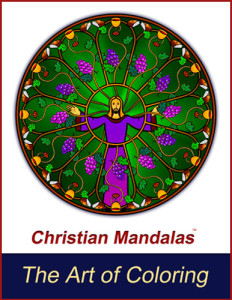 22 Christian Mandala Original Art Designs to Color
22 Christian Mandala Original Art Designs to Color
Christian Art
This is a Christian coloring book. It contains Christian themes created with detailed Christian Symbolism. You will notice a range of styles. Some pages are traditional stained glass window structures found in Christian Churches and Universities. In other pages, the designs become Escher-like. Other pages move further into abstraction. In each case, I have attached relevant passages from Scripture to reflect upon as you color.
Original Art
The pages are original art. In a few cases I have borrowed from Church and University stained glass windows that are close to my heart. In these cases I have altered and enhanced the original windows to read well in the line art format.
Art to make your own
I believe that coloring is an art form. The intent of this book is to enable coloring at a very high level. If time and thought is given to the pages the results will be new art of your own creation.
The Artist
The designs in this book were created by award winning Christian Artist Kerry Pierce.
Click here to buy at Amazon.com
The Family Coloring Book
22 Christian Mandala Designs and over 50 Symbols to Color
Designed for Young People
At one level, this is a coloring book full of images using the structure of classic stained glass windows found in Christian Churches throughout the world.
Designed for Families
At another level, the images in the coloring book utilize Christian Symbols. Each image, like a stained glass window, has a central theme. The symbols focus on the central theme. By becoming involved in the book as a family, the Christian Symbols become a language to help children understand the great Christian themes in a new, visual way.
A Learning Tool
There are over 50 Christian Symbols used in this book. Short descriptions are given for each symbol. The Symbols are used in 22 Christian designs, or mandalas, covering the breadth of the Bible. By using the symbols and discussing the imagery as a family, learning takes place on both a visual and verbal level.
The designs in this book are original art created by award winning Christian Artist Kerry Pierce.
Click here to buy at Amazon.com
Christian Mandalas† Small Group Curriculum:
The I AM Statements of Jesus Study
What is the I AM Statements of Jesus Study? Jesus is recorded as using I AM statements. He used these statements in order to explain who he is. This study will center on the creation of Christian Mandalas for each of the I AM statements. There are seven important I AM statements in the Gospel of John made during Jesus’ earthy ministry: I am the bread of life; I am the light of the world; I am the door of the sheep; I am the good shepherd I am the resurrection, and the life; I am the way, the truth, and the life; and I am the true vine.
After Jesus’ resurrection we are given two more important I AM statements in the Book of Revelation: I am the Alpha and Omega and I am the root and the offspring of David, the bright morning star.
The final I AM Scripture was posed as a question to the disciples, and recorded in the three Synoptic Gospels: Who do you say that I am?
The Christian Mandalas in this study will give the individual profound insight into who Jesus is.
Click here to buy at Amazon.com
The Interactions with Jesus Study
From the Baptism of Jesus to his Ascension, we find a series of interactions between Jesus and his disciples. These interactions often take place during pivotal events such as the calling of the disciples, the Transfiguration, the Last Supper, and the post-Resurrection appearances. Through the exchanges in this study we see Jesus calling and making disciples to shape the Church and engage the world. In the process, we observe the 12 disciples understanding of who Jesus is grow. Their reactions and flashes of insight are often dramatic. The Scriptures in this study work beautifully in the mandala study format. By creating mandalas for these interactions you visually and emotionally place yourself into the realities the disciples were experiencing. The visuals you create will give you new insight into the events and new understanding. Finally, the study gives us an opportunity to reflect on our role as disciples and the ministries we are called to.
–
–
–
–
The Psalms Study

The Psalms Study Visual artists often strive to capture human emotion. A quick look through the works of the European Renaissance or the Baroque period reveal facial expressions full of raw emotion. The works of Rembrandt, Leonardo, Rubens, and Caravaggio are full of vivid examples. Caravaggio’s The Taking of Christ is intense. Modern animators have words to help a character convey a message, but the words are backed up with mouth, eyelid, and eyebrow positions that reinforce the mood. Human expressions are commonly grouped into six categories: sadness, anger, joy, fear, disgust, and surprise. Of course, the range of facial expressions is limitless, but these categories are very distinct, and easy to recognize. These expressions convey emotion. When reading the Psalms, one immediately picks up on the raw emotions found there. The emotions associated with the six facial expression categories can be found within the Book of Psalms. Many Psalms, such as Psalm 5 and Psalm 89, convey multiple emotions within the text. The reason why so many emotions can be found within the Book of Psalms is because the Psalms were written at different points during Israel’s history. So one could encounter Psalms from the time of the monarchy, to after the Temple in Jerusalem was destroyed around 586 BC. Because of this, the Psalms deal with anything from praise and thanksgiving to bitterness and lament. The Psalms provide a window into how the Israelites interacted with God, both as individuals and as a nation. The Psalms in this study work beautifully in the mandala study format, because of the Psalms’ strong emotions and poetic imagery. The mandalas you create will give you new insight into the poetic expressions of the Psalms, and provide a way to reflect on your own interactions with God.
–
The Parables of Jesus Study
Perhaps one third of Jesus’ teaching recorded in the Gospels is in the form of parables. Matthew and Luke are especially saturated with parables.
The Parables of Jesus are brief, engaging stories spoken by our Lord. They are excellent. For me, they are riddles to be dug into. They require a bit of effort and reflection, but there is treasure to be found.
The Parables of Jesus Study explores ten of Jesus’ parable teachings. They are as relevant today as when he first spoke them.
Though not a requirement, the Parables of Jesus Study works best for individuals who have already completed one of the other Christian Mandala studies.
–
–
The Great Reversal Study
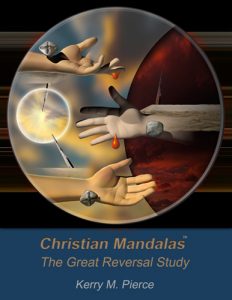 In the Gospel of Luke we find a recurrent theme which theologians refer to as the great reversal. These are unexpected, almost shocking statements from Jesus that cause us to stop and re-think our value systems. Sayings like: “Love your enemies”, “whoever would save his life will lose it, but whoever loses his life for my sake will save it”, “some are last who will be first, and some are first who will be last”, “It is more blessed to give than to receive”, and “For everyone who exalts himself will be humbled, but the one who humbles himself will be exalted”.
In the Gospel of Luke we find a recurrent theme which theologians refer to as the great reversal. These are unexpected, almost shocking statements from Jesus that cause us to stop and re-think our value systems. Sayings like: “Love your enemies”, “whoever would save his life will lose it, but whoever loses his life for my sake will save it”, “some are last who will be first, and some are first who will be last”, “It is more blessed to give than to receive”, and “For everyone who exalts himself will be humbled, but the one who humbles himself will be exalted”.
These great reversal sayings challenge us. “Love your enemies.” That is not easy. Reflecting on these great reversal sayings is often humbling. But God reminds us that he honors the humble, that the humble will be exalted.
In the great reversal study we find that the value system of the Kingdom is much different than that of our culture. The great reversal challenges us to focus on the Kingdom, rather than the world. We are called to use our energy, our love, and our gifts for the Kingdom.
The great reversal sayings, when reflected upon and applied to our lives, cause our focus to shift from our needs to the needs of others. Creating mandalas for these teachings will deepen your understanding of the great reversal and help you apply Jesus’ teaching to your life.
–
––
–
The Beatitudes Study
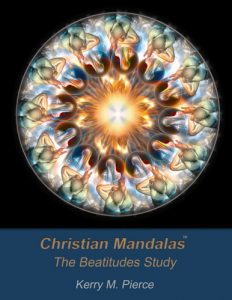
Jesus’ teaching and healing have begun to attract attention. As a result, large crowds began to follow him wherever he went. Matthew 5 begins, “Seeing the crowds, he went up on the mountain, and when he sat down, his disciples came to him. 2And he opened his mouth and taught them…”
Jesus wants to teach his disciples intimately. That he sat down and “opened his mouth” tells us that this is formal instruction on important content.
The first two blessings are surprising. “Blessed are the poor in spirit.” “Blessed are those who mourn.” Huh? Our first reaction may be that we do not want to be blessed if being poor in spirit and mourning are the conditions. Later blessings provide little relief, “Blessed are those who are persecuted for righteousness’ sake.” This message is the opposite of the world’s message. Blessed are those who are beautiful and spend money at exquisite venues, consuming goods and services with other beautiful people. “Blessed are the meek, for they shall inherit the earth.” What? Again, we are challenged. Isn’t it the proud, the powerful, the aggressive, and successful that accumulate the largest amounts of what the world has to offer? What does it mean to be meek?
Jesus moves our minds away from thoughts of an easy, prosperous life lived out by aligning with the world’s standards.
The Beatitudes have the perspective of the Kingdom of Heaven. The Kingdom is the unifying theme in Jesus’ discourse. In effect, the Beatitudes are guidelines for believers living in the Kingdom, as well as God’s blessings and favor towards those who aspire to live under his rule. Tidings of comfort and joy.
After the last Beatitude, Jesus states, “You are the light of the world.” What a compliment. Jesus says the same thing about himself in John 8:12, “I am the light of the world.” The Beatitudes enable us to become like Christ by teaching us Kingdom living.
Jesus’ Beatitudes are for believers, now. The blessings have started and will be fully consummated in heaven.
Level: Intermediate
–
–
Additional Materials/DVDs
Christian Mandalas: Revelation, Reason, Regeneration
Traditionally, mandalas (Sanskrit for circle or disk) are used in Hinduism and Buddhism to aid in meditation. Psychiatrist Carl Jung broke tradition by popularizing his own version of mandalas in the West to help with therapy. Jung’s ground breaking work with non-traditional mandalas led to the concept of the collective unconscious and eventually the development of the Myers-Briggs personality test. Christian Mandalas build on Jung’s work as well. By creating a mandala based off of Scripture, Christian Mandalas provide a unique way to visually engage with the Word of God. This approach also allows the Holy Spirit to interact with you on a deeper level, giving you even more insight as you create your own mandala. Your mandalas are images summarizing the Scripture you’ve read, and will stay with you throughout the day. By drawing from Scripture and having one-on-one time with the Holy Spirit, you allow yourself to become more like Christ. Loaded with images, this book gives you the essential background to begin your individual journey.
Click here to buy at Amazon.com
Christian Mandalas: The Leader’s Guide DVD
Christian Mandalas
The Leader’s Guide
The Christian Mandalas Leader’s Guide provides the essential background for facilitators to run a small group or life group together with the Christian Mandala study book materials.
26 Minutes/Color/Digitally Mastered/1.78:1 Widescreen
Click here to buy at Amazon.com
Fine Art Books:
Surreal Christianity—A Journey with Jesus, Jung and Dali
Surreal Christianity explores techniques found in Surrealistic art and goes on to show how Christians can use those techniques to approach Scripture in new ways. Ways which enable the individual to more fully love God with all their mind.
In this exploration, there are over 70 color images from artists, including: Bosch, da Vinci, Tissot, Chirico, Picasso, Dali, Pierce, and others. Centering on three passages of Scripture: Psalm 1:1-2, Matthew 22:26-28, and Romans 12:2, we learn how God intends for us to use our minds.
On this journey, you may also develop a deeper appreciation for surreal art and some of the Christians who were, and are, a part of the Surrealist movement.
Click here to buy at Amazon.com
–
Jesus, Escher, and the Art of Christian Morphing
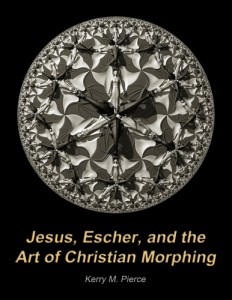 Jesus, Escher, and the Art of Christian Morphing explores the unique characteristics of the Dutch Artist M. C. Escher. The study explains how Christians can incorporate Escher’s qualities into their own interactions with Scripture. Interactions that enable the individual to morph towards Christ-likeness.
Jesus, Escher, and the Art of Christian Morphing explores the unique characteristics of the Dutch Artist M. C. Escher. The study explains how Christians can incorporate Escher’s qualities into their own interactions with Scripture. Interactions that enable the individual to morph towards Christ-likeness.
This investigation focuses on the Biblical Artwork of M. C. Escher. Escher’s visual reflections on Christ, together with three passages of Scripture: Matthew 17:1-8, 2 Corinthians 3:18, and Romans 12:2 teach us how to move forward on our Christian journey.
In this exploration, you will discover the spiritual side of Escher. An aspect of Escher not previously examined, but clearly revealed in his art, his lectures, and his personal letters.
You will also discover new techniques for studying Scripture. These techniques incorporate rules for how the brain learns best. Rules which Jesus incorporated into his teachings.
Click here to buy at Amazon.com
–
The Great Reversal: A Journey with Christ and De Chirico
In the Gospel of Luke and the book of Acts, we find a recurrent theme which theologians refer to as the great reversal. These great reversals are unexpected, almost shocking statements from Jesus, and interactions with Jesus, that cause us to stop and re-think our value systems. Sayings like: “Love your enemies”, “For whoever would save his life will lose it, but whoever loses his life for my sake will save it”, “And behold, some are last who will be first, and some are first who will be last”, “It is more blessed to give than to receive”, and “For everyone who exalts himself will be humbled, but the one who humbles himself will be exalted”.
These great reversal sayings challenge us. “Love your enemies.” That is not easy. But, Christ calls us to active discipleship. He calls us to operate as salt and light in the world. Engaging in the great reversal teachings of Jesus enables us to become more Christ-like.
In the great reversal study, we find that the value system of the Kingdom is much different than that of our culture. The great reversal sayings challenge us to focus on the Kingdom, rather than the world; to focus on the spiritual, rather than the sensory.
From late 1909 to early 1919, the artist Giorgio de Chirico painted through his metaphysical period. This decade is a unique moment in art when an individual bursts forth with a new style of painting. Thought was translated to canvas that the world had not yet seen. De Chirico’s works from this period form one of the most curious and fascinating moments in art history.
De Chirico’s works from the metaphysical period are meaningful because, like Jesus’ great reversal sayings, they deal with two different realms. The images encourage us to focus beyond the sensory and move to the spiritual. As such, they provide a visual means of understanding the intent of Jesus’ great reversal sayings.
Put another way, de Chirico’s art likely provides the best possible illustrations for Jesus’ great reversal sayings found in the Gospel of Luke and the book of Acts.
Click here to buy at Amazon.com
Bible Commentaries:
Hebrews – Access to God: A Visual Introduction
The Letter to the Hebrews is unique. A sermon written to a group of Christians facing persecution and wrestling with doubt, Hebrews is considered to be of the highest literary quality in the New Testament. The author employs Greek Philosophy, logic, and a wide range of passages from the Old Testament to encourage his audience to hold fast to their faith in Christ.
No other book in the New Testament highlights the supremacy of Christ or the high priestly role of Christ as Hebrews does.
Hebrews teaches us that Christians are the most fortunate individuals on the planet. Through the work of Christ, we have been given access to God.
Hebrews: Access to God is a Bible commentary for the rest of us. The treatment falls between an illustrated study Bible and a scholarly text. It employs fictional history, art, and explanation. The study is intended to make the Letter to the Hebrews approachable to all, serving as an introduction to the letter.
–
–
–
Click here to buy at Amazon.com
The Gospel According to John: A Visual Introduction
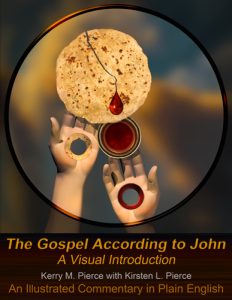 John’s Gospel is like a great film or work of art. Each time one returns to the text, they come away with a greater understanding and discoveries. Because the Fourth Gospel has multiple layers, individuals will find joy and learning with each reading. One can return to the text repeatedly and never wholly uncover the treasure John has left for us.
John’s Gospel is like a great film or work of art. Each time one returns to the text, they come away with a greater understanding and discoveries. Because the Fourth Gospel has multiple layers, individuals will find joy and learning with each reading. One can return to the text repeatedly and never wholly uncover the treasure John has left for us.
One ponders how a first-century fisherman from the north end of the Sea of Galilee created a book with such highly developed thought and depth. I believe John was a brilliant individual who co-authored the text with the Spirit.
An introductory fictional short story sets up the overall context for John’s Gospel. The commentary uses plain English to unpack the meaning of each chapter of the Gospel. Fine art and other visuals are used to aid in understanding John’s masterpiece.
John’s Gospel explains the mystery of Jesus unlike any other book of the Bible. This study provides an introduction for all who are curious.
–
–
–
Click here to buy at Amazon.com
1 Peter: A Visual Introduction
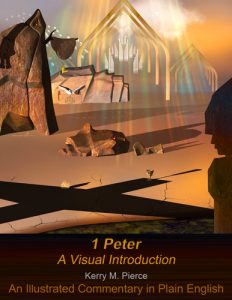 With the letter of 1 Peter, we have the thoughts of the great disciple at the peak of his spiritual maturity. Peter’s letter gives hope to Christians living within a larger, unbelieving community. He helps us to understand how valuable we are to God. Peter explores the realities believers stand to inherit, explaining that God has a purpose for all we go through. He also tells us how to deal with our challenges, including practical advice for living in a sometimes hostile world. God has a plan for each one of us, and it is good.
With the letter of 1 Peter, we have the thoughts of the great disciple at the peak of his spiritual maturity. Peter’s letter gives hope to Christians living within a larger, unbelieving community. He helps us to understand how valuable we are to God. Peter explores the realities believers stand to inherit, explaining that God has a purpose for all we go through. He also tells us how to deal with our challenges, including practical advice for living in a sometimes hostile world. God has a plan for each one of us, and it is good.
1 Peter is increasingly applicable to the situation Christians find themselves in today. Studying Peter’s short letter is invaluable if you need Christian encouragement and guidance.
An introductory fictional short story sets up the overall context for 1 Peter. The commentary uses plain English to unpack the meaning of each chapter of the Letter. Fine art and other visuals are used to aid in understanding Peter’s masterpiece.
–
–
–
Click here to buy at Amazon.com
Philippians: A Visual Introduction
In Philippians, Paul gives us a letter written to friends and partners in the gospel. The apostle’s words are full of rich, deep thought.
Paul gives us the epic passage on humility, using Christ as the ultimate example, and imparting one of the greatest moments in the New Testament. Reviewing the radical honor-shame culture of the ancient world, we begin to understand the depth of Jesus’ work for us. Christ’s life and work are an act of humility that cannot be equaled.
Paul exhorts the Philippians to adopt Christ’s attitude of prioritizing the needs of others above their own.
The high theme of individual and collective humility will drive unity in the church and build the Philippians into a united community of highly developed believers. The Philippian church went on to reflect the light of Christ to the unbelieving world surrounding them without undue regard for their situation. The Christians at Philippi progressed in their faith and advanced the gospel.
The underlying themes of humility, unity, and joy in the Letter to the Philippians give us the characteristics of a healthy body of believers suitable for the primary objectives the great apostle sets forth.
Due to its universal themes, Paul’s Letter to the Philippians is relevant for the Church today.
An introductory fictional short story sets up the overall context for Philippians. The commentary uses plain English to unpack the meaning of each chapter of the Letter. Fine art, including that of the Pre-Raphaelite Brotherhood, and other visuals are used to aid in understanding Paul’s great letter.
Click here to buy at Amazon.com
† Christian Mandalas is a trademark of Kerry M. Pierce.

